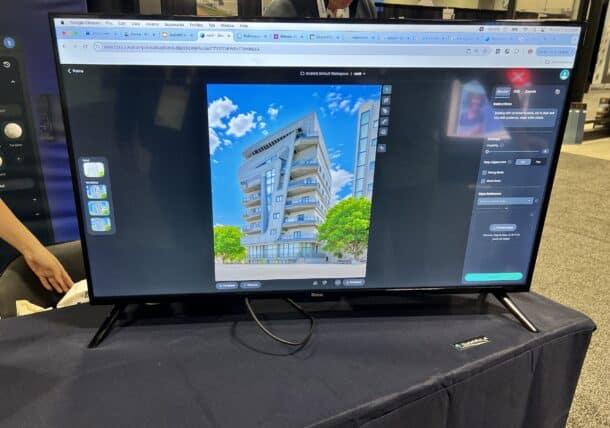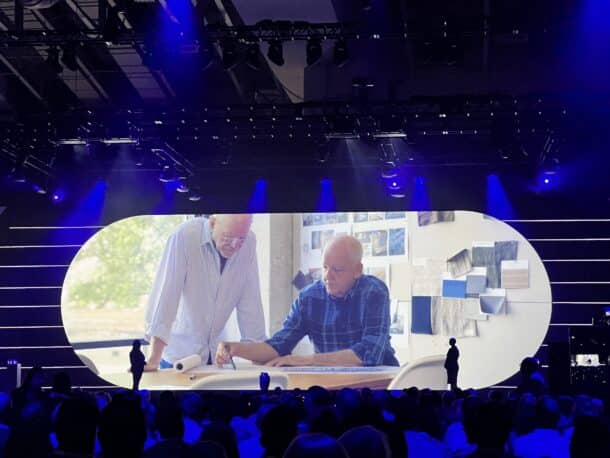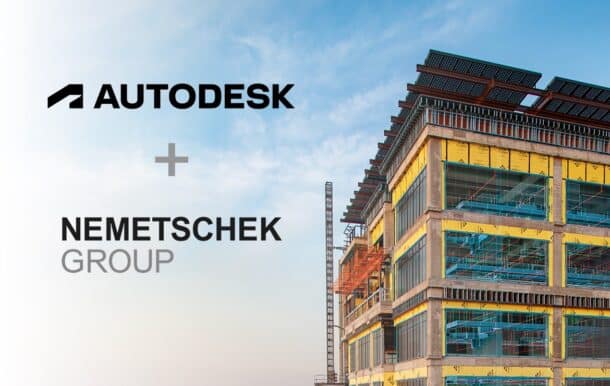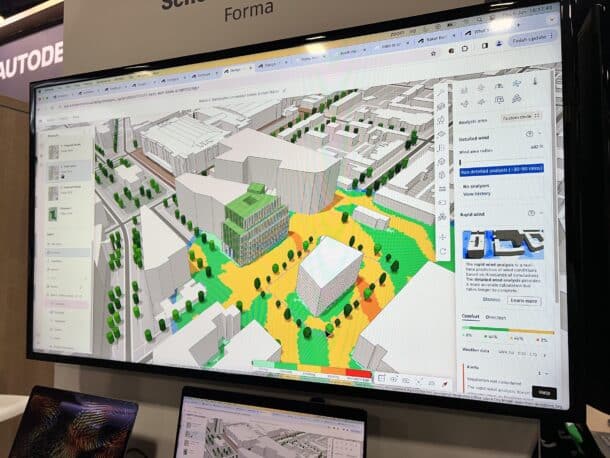AS WE COMMEMORATE THE 10TH ANNIVERSARY of this publication’s coverage of the AIA National Convention, it’s a fitting moment to reflect on the decade-long coverage highlighting what we felt were the most significant digital tools (both software and hardware) exhibited to architects. Rather than summarize the history of particular tools and companies, we would rather drill down into key themes (we have called this our thesis) that we have felt are tremendously important to the health of the profession.
Our Goal with Themes
While each year, the AIA convention itself can be thematic in terms of focus and keynote speakers, we have identified foundational themes and trends shaping the world of digital practice for architects and have written about these in our annual “Perspectives” features. For example, in 2013, we wrote about the waning relevancy of “design intent” as a legal concept as the AEC industry began to move slowly toward fabricators and DfMA (Design for Manufacturing and Assembly) workflows. In 2015, we noted the rise of VR headsets and the “game-ification” of architectural tools as they began to borrow both concepts and direct technology.
In 2016, we focused on educating architect readers about the Gartner Hype Cycle, adding a temporal context to a rush of new innovations, like VR/AR devices and software. In 2018, we stepped back to a much larger temporal perspective and introduced readers to business cycles theory, specifically Carlota Perez’s famous Techno-Economic Paradigms (TEPs) theory model.
The goal each year was simple: use business, innovation, and economic themes (as overlays) to help readers assess the importance of each year’s new products and innovations.
Another goal was to give us structure for what may seem (and is) subjective determination in award winners. To make the Architosh AIA BEST of SHOW honors less subjective, we developed criteria to support three foundational themes we feel passionately are paramount to the health of the architectural industry. They are listed below.
- Social and Democratization of IT (information technologies)
- Computational Power and the Cloud
- Creativity and the Contemplative Pace
These three foundational themes are essential social forces and goals, working simultaneously as phenomena and aspirations.
For instance, cloud computing, which is an essential development driving the smartphone era, signifies a further democratization of the personal computing revolution that started in the late 1970s. While the Internet initially provided static and then dynamic data, the crucial difference in democratizing computing beyond the desktop is the delivery of software as a service (SaaS) through the web browser. This enables a wide global audience to benefit from useful applications, spreading the power and advantages of these apps liberally.
Part 1
The Market Can Be Wrong
Today, the social and democratization of information technology echoes calls for diversity and inclusion in all spheres of liberal societies. We feel strongly that the rationale for the inclusion of diverse perspectives in any field has its digital similitude in the ideas and innovations of software and computing hardware. Many diverse perspectives enrich society’s set of options for moving forward. Thus, we find in a diversity of technology providers—who operate in competition with each other—a richer set of competing ideas that are far less mutually exclusive than market forces may portray.
This year, we acknowledge Autodesk and the Nemetschek Group’s recent API partnership, which fundamentally shifts these two software giants into a more cooperative posture. The essential economic problem with the AEC industry is the lack of data interoperability. AEC professionals wrestle too much with moving both geometric and non-geometric data amongst their many project stakeholders. It is so difficult, in fact, that most times, users replicate the “data input process” into the tools of their choice. And this, it turns out, is very inefficient and costly. While it is tempting to imagine most AEC stakeholders’ needs can be met optimally by a single monolithic tool or platform, such an idea is unrealistic.
We feel strongly that the rationale for the inclusion of diverse perspectives in any field has its digital similitude in the ideas and innovations of software and computing hardware.
The software market often suggests a winner-takes-all format for an industry. But markets learn repeatedly that while that may solve one key common issue in interoperability and standards, it generates a host of new economic issues. The essential article to understand this dynamic is our own 2022 special feature on the Nordic Revit Open Letter. (see: Architosh, “The Revit Open Letter Through the Lens of QWERTY-Nomics,” 20 Oct 2022).
While the API partnership announcement is a step in the democratization direction, readers might be interested to know that similar industries—like the semiconductor industry with its need for EDA (electronic design automation) software of various kinds, have operated with an industry standard for two-plus decades. Back in 2000, Cadence, one of the big market leaders in EDA software, licensed its Library Exchange Format (LEF) and Design Exchange Format (DEF) to rival Synopsys. The EDA industry also has many interoperability initiatives, including ecosystem compatibility validation.
The EDA industry consists of many different types of software tools doing very specific things. The three largest industry players—Cadence, Synopsys, and Mentor Graphics (now part of Siemens) dominate more than three-quarters of the market, but each has dozens of “best-of-breed” tools that customers in EDA mix and match, despite each having full-stack software solutions. Chip designers like Apple, Intel, and Qualcomm use these tools, as do chip manufacturers like Intel and TSMC, in various combinations. The chart below shows the diversity in market share leadership in specific types of tools.

The largest EDA software product segments, showing “best-in-class” leaders, are evenly distributed across the three largest EDA software providers. (Image: Gary Smith EDA Market Trends, 2015)
The chart above and the EDA industry are illustrative for AEC. What if the AEC software market operated in a similar vein? What if Autodesk, Trimble, Bentley, and the Nemetschek Group formed an industry group to test and validate their families of software tools for consistent data interoperability between rival tool platforms? This idea goes beyond IFC and what buildingSMART has achieved. That effort has left the industry wanting.
If the AEC industry operated like the EDA market, customers would have greater freedom to work with their data using the best-of-breed tools available, thereby optimizing their workflows.
Era of ‘Co-opetition’
It turns out there is a term for this idea. It’s called “co-opetition”—cooperation plus competition. According to this Harvard Business Review article, rivals are working together more than ever. As mentioned earlier, two major AEC industry tech giants—Autodesk and the Nemetschek Group—formed an agreement to mutually open up each other’s APIs to improve AEC/O industry workflows long fraught with data interoperability pain points.
The proverbial 800-lb gorilla in the US AEC industry—Autodesk—has long been accused of leveraging its dominant market share position. As we explain in this special feature on the Revit Open Letter movement, Autodesk doesn’t act alone in acquiring and maintaining its market dominance. Quite the contrary, market dynamics in themselves nearly guarantee that any market-dominant firm bordering the power of a natural monopoly will assuredly conduct itself in a particular way that will upset not just its smaller rivals and their customers but eventually a critical set of its own customers.
The way Microsoft transformed itself under CEO Satya Nadella was to re-orient itself to services instead of devices like the Windows PC.
2024 marks a watershed moment for Autodesk. While we may never know every reason why the American CAD giant formed a partnership with its strongest (and European) rival, lessons from Microsoft’s history may now factor into its recent calculus. Just like Microsoft with its Windows and Office dominances, the winds of growth have primarily filled Autodesk’s sails in the form of AutoCAD and Revit licenses. So, what is the specific lesson Autodesk should learn from Microsoft, aside from the emphasis laid out by the signatories of the first Revit Open Letter?
It can learn how to thrive in the era of the decline of BIM 1.0 just as Microsoft has learned to thrive in the decline of Windows and the desktop PC.
In a BIM 2.0 era, the desktop platform cannot anchor its power and is at risk of sudden disruption. This is what happened to Windows and Office for Microsoft. The sea change was the massive transformation of smartphones and the cloud. Android and iOS are the dominant platforms at the present moment on the dominant device—the smartphone. The computing world changed rapidly when considered in hindsight, the same way it changed when the PC shook up the main frame and minicomputer era.
The way Microsoft transformed itself under CEO Satya Nadella was to re-orient itself to services instead of devices like the Windows PC. To redirect yourself away from the center of the thing that made you hugely successful is no small feat, which is why CEO Steve Ballmer couldn’t do it. Autodesk’s market position isn’t the same as Microsoft’s years ago. However, a notable shift was called for when, in 2022, CEO Andrew Anagnost proclaimed at Autodesk University that the company was going to disrupt itself and introduced Autodesk Forma.
Forma is Autodesk’s “industry cloud” for AEC/O, but the California-headquartered company has an industry cloud in every major market it serves. This marks the reality that the company, in a similar vein to Microsoft, has reoriented itself away from the desktop-era device and toward the cloud.
While the PC allowed companies like Microsoft and Autodesk to build dominant businesses across the horizontal model of the PC ecosystem, today, the IT industry must contend with multiple device ecosystems with the cloud at the center of all of them—from smartphones to tablets to headsets and game machines to smartwatches and, yes, even the PC. As Ben Thompson wrote:
“Nadella…needed to break up Windows and end Ballmer’s dreams of vertical domination so that the company could build a horizontal services business…”
In the end, Nadella converted the mindset and culture of Microsoft to shift the focus so that “non-Windows platforms would be targets for Microsoft services, not competitors for Windows.”
It’s really hard not to look at Autodesk Forma and Autodesk Platform Services (APS ?) and think about a similar strategy at play here. With an API partnership with your closest rival, Autodesk can allow Nemetschek’s customers to tap into Forma as a service that delivers something to the Nemetschek customer that the “Group” can’t yet offer. At the same time, the partnership enables Nemetschek’s many leading engineering apps in Europe to better integrate into Revit and Autodesk Construction Cloud projects. To us, “Co-opetition” means allowing existing competitive solutions to compete but forming cooperative partnerships that enable the flow of customer data between rival ecosystems. We know “co-opetition” works because it works in EDA, which has many different kinds of tools, just like the AEC/O industry.
The Autodesk + Nemetschek Group API partnership, in principle, begins to address this concern, at least for the tools in each respective ecosystem.
In a previous article, we noted that Nicolas Mangon, Autodesk Vice President of AEC Strategy, told Architosh that the number one reason for this new agreement between both companies is that AEC demand worldwide necessitates improved workflows. Thus, we may now see apps like Bluebeam integrated into Autodesk Construction Cloud (ACC) workflows and Forma integrated into Archicad workflows.
Such a thing counters the power or sway of “ecosystems” that recently Nirva Fereshetian, CIO of CBT Architects of Boston, noted this way. “So unlike other tools—and I think, progressively, everything is platform-based now—it will become harder and harder to say we will replace one tool with another because the decision becomes entirely dependent on the ecosystem to move together.”
MORE: AIA24: Architosh 10th ‘BEST of SHOW’ honors for digital technologies at AIA National Washington DC
The Autodesk + Nemetschek Group API partnership, in principle, begins to address this concern, at least for the tools in each respective ecosystem. It all marks progress for users and for the further democratization of IT.
“Co-opetition” appears to be a transformative strategy now occurring in the industry, like the EDA industry, and with BIM 2.0 in AEC/O, combining competitive and cooperative dynamics to blending technology and accessibility for users and customers. The same paradigm shift can be seen in the broader landscape of Industry 4.0, where traditional industrial boundaries are dissolving in favor of interconnected ecosystems. In this new era, reinvention is driven by the integration of cyber-physical systems like the Internet of Things (IoT), Artificial Intelligence (AI), robotics, autonomous vehicles, and spatial computing, creating smart factories and supply chains that are more adaptive, efficient, and responsive to changing demands.
Part 2
Detroit as Parallel for Profession
Today’s “connectedness” provides a wider lens through which to consider the context of the AIA24 proceedings. As AIA President Kimberly Dowdell welcomed Dr. Sanjay Gupta to the Friday keynote for the general session, they both gave a shared “shout out” to Detroit as a point of origin and generally the important influence that Detroit has provided their history as it has for many others. Published in FastCompany the same week as AIA24, Detroit was presenting its own project that should influence the AIA body and beyond. The Michigan Central Station reopened to the public on June 6 with new life breathed into it. Ford Motor Company took the civic responsibility to restore this Detroit marquee and longtime urban center of decay.

Dr. Sanjay Gupta at the keynote at AIA24 on Day General Session. Dr. Gupta and AIA President Kimberly Dowdell both had common Detroit backgrounds.
This intensive effort included many aspects that were exemplary in their attention to restoration. Advanced techniques and technologies provided a path to realization that may not have otherwise been possible. Complex details and focal points were rebuilt around 3D digital scans and even 3D-printed components, resolving their own complexity.
This effort was part of a partnership and vision around creating new opportunities, new technologies, and industries. The Michigan Central Station is set to be a part of a 30-acre campus oriented to new work around mobility, novel technologies, and public realm improvements to become a living civic center in addition to a literal one for the community. Reinhabited neighboring structures are also engaged in this vision, with some organizations up and running already, plus other improvements to adjacent public spaces. This vision is far from being proven a success for its urban constituents, but the effort is clear and even a clarion to the architectural profession.
The ideas exemplified around new industry and reinvention at a measurable scale are happening within this Detroit project. The idea around industry 4.0 can be seen all around in this effort and is community-based, focused, and even led, as shown by Newlab, as one of the early involved organizations creating a place to support the synergy toward “a more equitable, resilient, and sustainable world” seeing innovation from adversity and diversity. What Newlab has grown in New York is what is similarly envisioned for Detroit’s communities.
MORE: AIA24: Architosh 10th ‘BEST of SHOW’ honors for digital technologies at AIA National Washington DC
The hardware and software systems around AEC/O, which Architosh has discussed for decades, are clearly and quickly evolving. BIM 2.0, as previously discussed, is a clear element in that evolution. Cloud computing, spatial computing, AI, robotics, and more are reshaping what has been understood as a profession and industry for many more decades. President Kimberly Dowdell even spoke to that heritage at the conference, noting the well over 100-year history of the AIA. The changes today are and will be drastic. Seeing the dramatic impact AI is having on that conversation is clear. On the conference EXPO floor, AI drew an amazingly large informal crowd in the Architecture Innovation Zone. The anxiety is justified. New tools today are able to envision the built environment and can be altered in ways unimaginable from just a few years ago.

AIA24 the Innovation Zone was packed with attendees anxious to learn about topics like AI.
SketchPro.AI was exhibited on the EXPO floor this year and showed a compelling tool that visualized convincing architectural designs in minutes. The skills required to accomplish these are not the same as those required in the recent past. The subtlety and nuance were intriguing and shocking.

SketchPro.AI is a new exciting AI visualization tool exhibited at AIA24.
Architectural practice—and the academy that prepares individuals for it—will need to re-envision itself as the Michigan Central Station has achieved. The profession must come to grips with the understanding that the world has truly changed and that in moving forward, just like in Detroit, sometimes we should look back and recapture the value of past achievements. At AIA24, in the innovation zone, what this can look like is witnessing the power of a well-drawn three-dimensional hand sketch as input to a tool like SketchPro.AI. Suddenly, hand-drawing gains a new powerful buddy (AI). And not just hand-drawing but working with your hands in model-making. Over at the Graphisoft section in the Nemetschek booth, AIA24 attendees were treated to an experimental lab of sorts where attendees could play with blocks to build something, and a camera would feed that physical image into an AI system, which would then render it with sky, foliage and detailed materials and facade arrangements.

Exploring Graphisoft’s AI technology exhibit where physical blocks are merged with a computer vision pipeline and AI technologies apply rendered background and facade materials. The blocks, in this case, were cups turned upside-down, some toy blocks sitting on top, and other objects on the table in the corner.
The combination of computer vision and AI plus traditional model-making reminded us of Frank Gehry’s tactical analog process of designing by folding paper and cardboard. It also speaks to a foundational theme in our AIA Perspectives writings—the importance of creativity and the contemplative pace.
So, the future is not about renouncing the old for the new but about reimagining how emerging technologies may bring back the relevance of the old. And what better exemplar than what is happening in Detroit? While Detroit is a literal physical model of this reimagining, Graphisoft’s experimental AI and model block-making exhibit brings to mind the work of Heidi Hayes Jacobs, a world-renowned curriculum designer who notes importantly that technology is not just impacting students but can transform teaching itself. In a similar vein, the Media Room at CBT Architects in Boston combines green-screen technology and the live human figure in ways novel to the field but familiar to Hollywood. The CBT model shop is also doing novel things, merging the digital (new) with the analog (old).

An image of CBT’s new Boston office showing colleagues, along with Nirva Fereshetian, CIO at right, on the interactive digital-to-physical 3D model screen. (Image: CBT Architects)
This synthesis of past, current, and future transformations echoes a discussion at AIA24 by Dr. Sanjay Gupta, who also described being able to transition his journalism skills rapidly on demand to perform surgery during the war in the Iraq desert—a shift from divergent creative thinking and doing to critical thinking and production, where being creative about brain surgery protocols would not be a healthy practice.
This shifting in mental frameworks and even between domains, like an “M” shaped designer, is a part of this new thinking and doing work redefining a civic, cultural, and commercial center occurring at Michigan Central. New capacities are required to exist in a re-envisioned healthy environment, with lessons to be learned and not lost but reconsidered with new practices and capabilities. Likewise, as architects have historically synthesized context and design concepts as a part of their core, two members of the AIA were celebrated for elevating this synthesis at a critical time in today’s natural environments and built landscapes.
Nurture | Nature – Lake Flato (part 3)
The 2024 AIA Gold Medal was awarded to Lake Flato founding partners David Lake and Ted Flato. The award was presented at the Friday general session. The firm, for the past 40 years, has been responsible for the most COTE Top 10 awards for a firm (15) and has established Lake Flato’s leadership around social and environmental stewardship and inclusive design processes and practices.
Receiving this prestigious award, Lake and Flato wasted no time speaking about their belief in design and its impact on nature. They said pointedly and to their joint award, “Design is not a singular act.” This collaborative nature echoes truth in this year’s Architosh BEST of SHOW awards, where BIM 2.0 and new tools are pointed, more dynamic, and extending traditional monolithic tendencies.

David Lake, FAIA, and Ted Flato, FAIA were awarded the 2024 AIA Gold Metal.
Lake and Flato’s commitment to a human-centered inclusive process is not isolated but concerted and inviting to their environment. “You won’t design a better tree than Nature” also spoke to their commitment and respect for the natural environment. Lake and Flato called for “Nurturing Nature,” a respectful positioning for any designed interactions in nature.
This call to the profession was also reflected in the focus of tools represented at AIA24, where a digital twin’s most compelling case might be in its ability to inform its constituents of its environmental performance, impact, and situation in real-time—providing a next level awareness and ability to act in concert with a more empathic triple bottom line philosophy. As strong examples, Autodesk Forma and Chaos Enscape both exhibited this capacity as a central focus this year. Complicated embodied carbon counting is closing in on a “1-click” mentality.
MORE: AIA24: Architosh 10th ‘BEST of SHOW’ honors for digital technologies at AIA National Washington DC
While not mature, an area of intention around these tools is inviting a broader audience for active participation, growing the language, and moving the conversation forward. This democratizing of these environmental analysis tools also promotes thinking and knowledge of building impacts and activities that can be optimized.
For instance, the pandemic put a strain on interior building environments and health awareness with air quality. One solution was a desire for outdoor work. This trend has not backtracked, and outdoor work trends continue to grow. Tools like Forma provide the capability of understanding not just macro-environmental behaviors but also micro-environments that would also impact the viability of a potential outdoor work environment.

The Gold Metal Award honors, in the case of Lake Flato, four decades of placed-based, sustainable, and inclusive architecture.
The idea of “nurturing nature” is intended to positively influence the impact buildings have on their natural existing site and ecosystem to the bar of a doctor “doing no harm” if the patient were the building site and the building was even considered a healing act. This geocentric perspective from Lake and Flato is reflective of human-centered design strategies, except perhaps as a life-centered design approach.
Ultimately, Lake and Flato put another mark on this year’s conference and represented a theme of connecting—to the land, to the environment, and to each other in profound ways. The advancing technologies also echoed this idea in a nuanced way. It’s a human act. It’s a complex act. Design can be inclusively democratizing and address complexity in ways that are rich and within an inclusive process, empowering and improving those most impacted.







